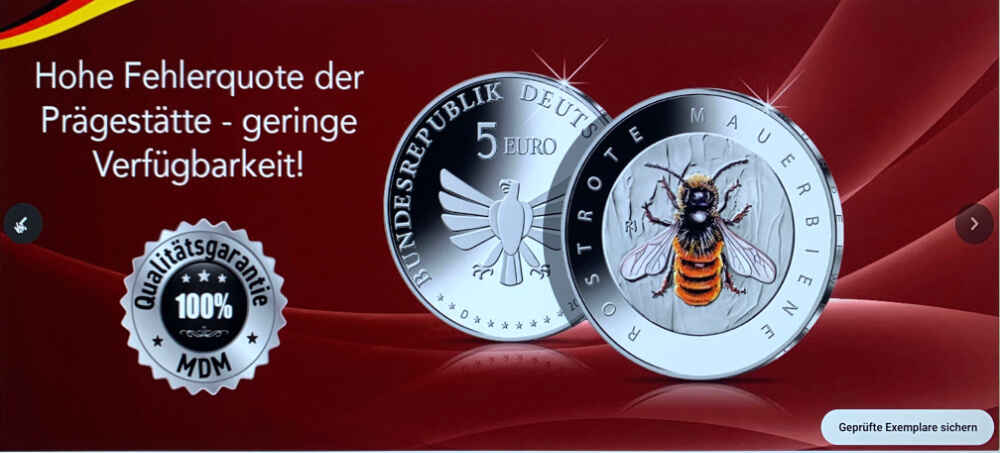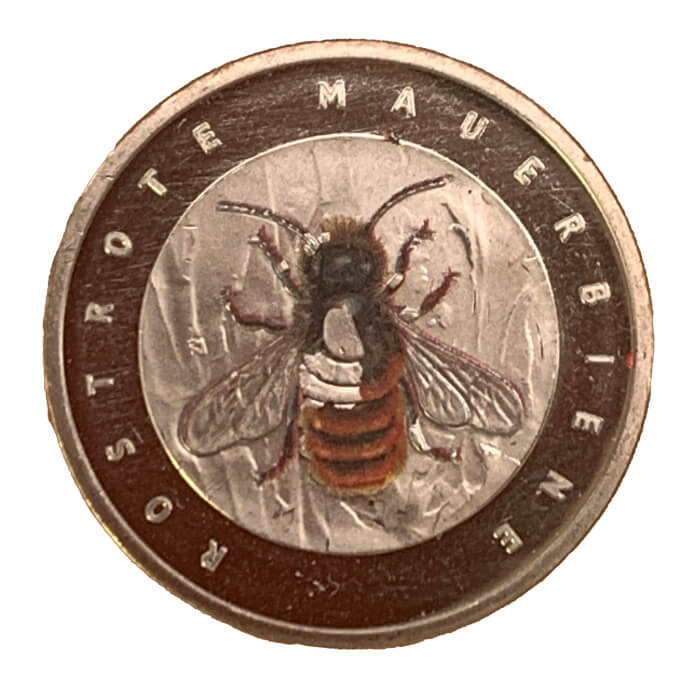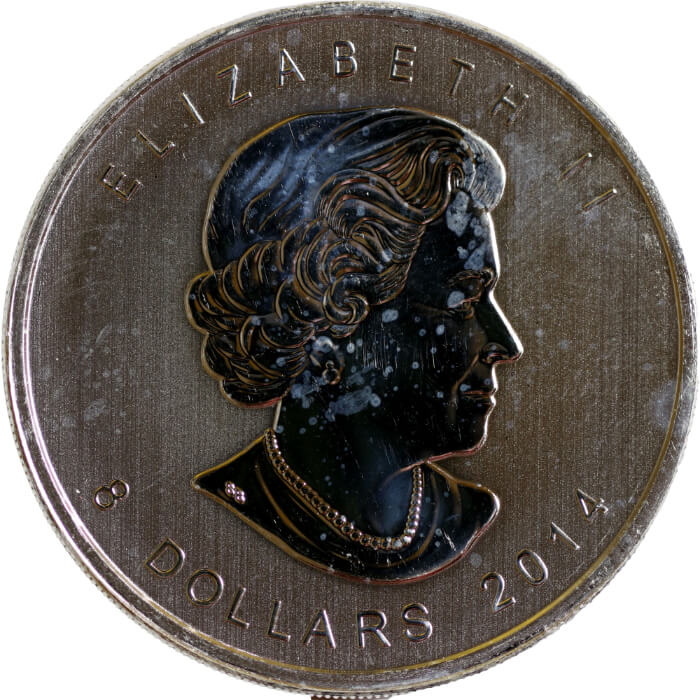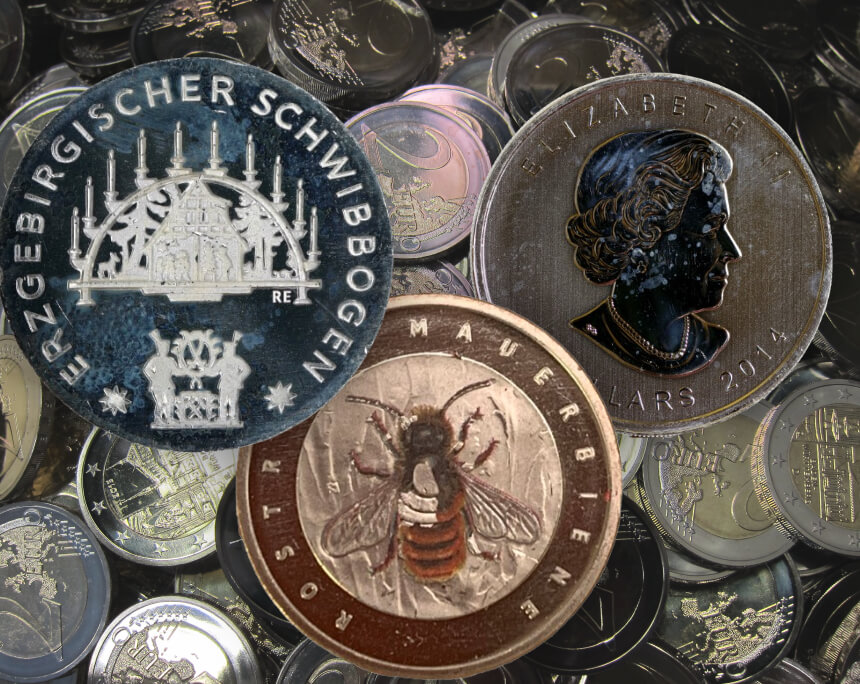An “Error Coin” No Collector Is Happy About
by Sebastian Wieschowski, translated by Maike Meßmann
The German mail-order company MDM usually promotes numismatic issues highlighting sophisticated special effects, particularly low mintage figures or other superlatives. But shortly after the release of the 5-euro collector coin “red mason bee” of the “wonderful world of insects” series, customers of the MDM shop were confronted with an advertising slogan that has probably never been seen before in the world of German numismatics: “High error rate of the mint – low availability,” it read. In addition, MDM apparently felt the need to give its customers a “warranty of quality” for the “examined specimens” offered in their shop.
Content
It would be easy to roll one’s eyes at this message, dismissing it as just another “marketing stunt” from a mail-order company. And yet, once you consider the situation as a whole, this paints a sorry picture: Has it become a unique selling point of some German specimens that they do not display any errors? Does a “high error rate” really make a contemporary collector coin particularly rare? And aren’t “error coins” usually highly coveted by collectors?

Guaranteed flawless specimens of limited availability – the mail-order company MDM highlighted the production problems of the German insect coins, turning them into a selling point. Photo: Sebastian Wieschowski
It appears that some dealers did indeed struggle to find immaculate specimens of the “red mason bee” to offer to their customers. Numerous companies confirmed this when contacted by CoinsWeekly. One of the major players in the industry said that their company had to complain about a quarter of the delivered coins. They suspect that “the coins were wrapped in rolls too early, before the colour had completely dried. On some coins, the colour came off completely.” Another company mentions “serious problems” and confirms that about a third of the coins ordered had to be sorted out and returned.
The exact extent of production problems is unknown, as is the cause: “Unfortunately, we are not in a position to make a clear statement as to how many coins are affected by this,” Germany’s central bank Bundesbank told CoinsWeekly. One of the dealers CoinsWeekly spoke to noted that the problem only concerned “red mason bee” coins and that later designs were delivered without quality problems.
From Pad Printing to Digital Printing
The Federal Republic of Germany has issued colour collector coins since 2019. After releasing one 20-euro silver coin a year with this technique, Münze Deutschland, responsible for sales and distribution of German collector coins, presented the “wonderful world of insects” series in 2022. While silver coins were produced using pad printing, a process that only allows for a few colours to be used, the mint switched to modern digital printing technology for the base metal insect coins. This makes it possible to create colour gradients and photorealistic details on the coin – with the help of special ink that is supposed to resist circulation wear.

Parts of the colouring came off a specimen of the 5-euro “red mason bee” collector coin, which was presented to CoinsWeekly. This seems to be a frequent phenomenon. Photo: Sebastian Wieschowski)
In addition to German colour coins, silver collector coins have also been the subject of recent debate: following the first issue of the 25-euro silver coin “Erzgebirgischer Schwibbogen”, some collectors reported edge chips as well as “milk spots”, i.e., white deposits on the coin metal that cannot be removed without damaging the coin. However, in this case, the Bundesbank has officially given a statement: “At present, we are not aware of any complaints from other branches on point of milk spots, with the exception of a single coin”, reads a statement from the Bundesbank in response to an enquiry from CoinsWeekly.
Random Checks Found No Defective Coins
According to the Bundesbank, normal mint condition coins are produced and packaged in a fully automated process, resulting in a high mintage figure of around 700,000 pieces. “Blanks and coins are randomly checked at the mint. Due to the production process and the high number of coins, it is impossible to check all pieces,” emphasised Bundesbank spokeswoman Anne Grüttner.
Only silver blanks that were put through a complex cleaning process at the manufacturer were used for the production of the coins. The blanks were inspected on arrival at the mint and no spots were found. “Milk spot” coins were not spotted either when the pieces were inspected during the minting and packaging process. “However, we cannot rule out the possibility that individual spots may appear on the coins after the minting process as a result of deposits on the blanks,” explains Grüttner. The Bundesbank will therefore continue to monitor the situation.

Many investors have become accustomed to milk spots on silver bullion coins. It is remarkable that the spots appear on silver coins from a variety of countries and production facilities. Photo: Sebastian Wieschowski
It would be desirable for German collectors and mints that milk spots on German collector coins actually remained isolated cases. After all, the phenomenon is widespread throughout the coin world: “Unfortunately, many sometimes brand-new issues show milk spots. This applies in particular to new 1-ounce silver coins from Somalia, Austria and Canada, but also to many other silver issues from all over the world,” comments a dealer. Although complaints are registered with the issuers, the defects are rarely remedied.
In fact, mints across the globe say they are working tirelessly to uncover the causes of these so-called “milk spots”. The Royal Canadian Mint says they have been a “concern for mints and investors around the world for years” and has developed a proprietary technology called “Mintshield” to address the problem. The Perth Mint stated in an article that it is most likely that microscopic airborne particles inside the mint are causing the stains.
Cracking Down on the Milk Spot Mystery
The general consensus is that the debris gets onto the coins after the actual minting process. And what is particularly problematic for collectors is that milk spots can take a long time become visible. There are coins that have been graded by a third-party grading service and only developed milk spots after being encapsulated. Vacuum sealed containers – a particularly popular method in the field of contemporary silver bullion coins – also do not seem to help prevent milk spots. Thus, collectors, dealers and producers alike are looking for the causes of the unattractive veil that suddenly appears on coins.








